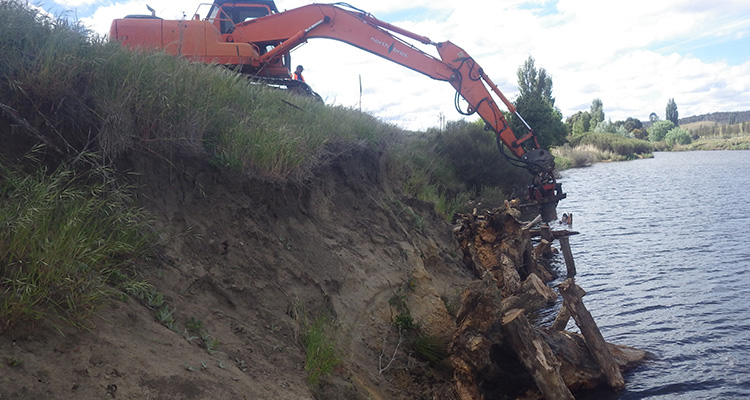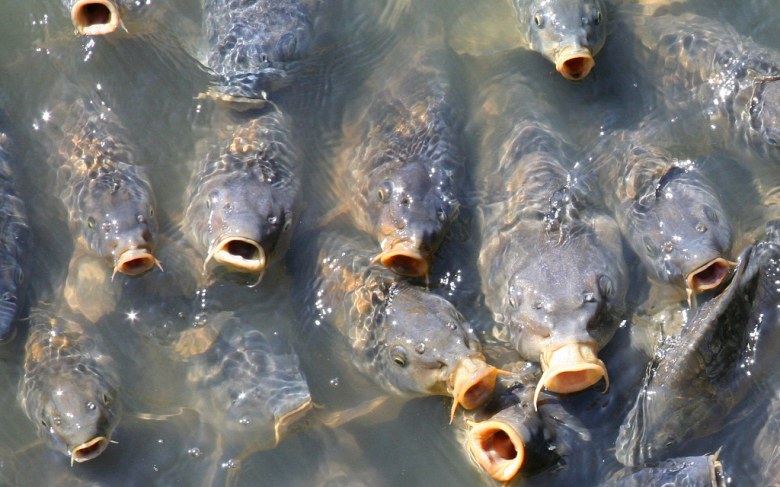European Carp have been using the warmer water temperatures of spring to move across the Snowy Monaro, bringing their destructive ways into new habitats.
Since the 1850’s, Carp have been spreading out into low land waterways like the Murray-Darling Basin, but in the last ten years, these ferals have been moving into higher elevations, places once thought too cold for them.
Carp were introduced to Australia in an attempt to imitate a European environment – some nice cheese and wine could have done the job!
Despite being a native of Central Asia, carp are extensively farmed in Europe and the Middle East and are a popular angling fish in Europe. Eating carp is also a Christmas tradition in some cultures.
Carp in North America and Canada are also considered a significant pest.
Cooma Region Waterwatch Coordinator, Antia Brademann has eaten carp but doesn’t recommend it. Her interest is working with the community to build knowledge and share information and use it as part of locally tailored control programs.
Posted by Lauren Van Dyke on Sunday, October 29, 2017
The Carp Love 20 degrees campaign is key to those ambitions and is helping build a local profile of the fish. The program asks people to report carp sightings to the Feral Fish Scan website.
“Carp have a temperature trigger, so as water temperature gets to 20 degrees, that’s their spawning trigger, they need (and indeed love) that nice warm temperature,” Antia says.
Cooler water temperatures have perhaps slowed the pest’s progress across the Snowy Monaro, that is no longer the case with carp fanning out through the Upper Murrumbidgee River Catchment including the Bredbo and Numeralla Rivers, Cooma Creek, and into Canberra.
“They are moving, looking for suitable spawning habitat, “Antia says.
Locally that habitat looks different to what has been considered normal or ideal carp spawning areas – off stream wetlands, like those of the Lachlan River system, where large amounts of water gathers in shallow areas.
“In the Upper Murrumbidgee, we don’t have those big off stream wetlands, so we weren’t sure what the ideal spawning habitat looked like locally,” Antia says.
“Unfortunately from Carp Love 20 over the last three years, we are finding that carp spawning locally is opportunistic and variable.”
Carp spawning in the Upper Murrumbidgee catchment
Conditions are perfect to spot carp breeding. Anyone can do it! Waterwatch needs your help to better manage this pest species. #carplove20
Posted by ACT Landcare and Waterwatch on Thursday, November 2, 2017
A 6kg female can lay up to 1.5 million sticky eggs, attaching them to submerged vegetation or rocks in shallow water where they wait for a male to fertilise.
“We think that carp in this part of the world might have a number of spawning runs outside the traditional October to December window, because of the variability of local temperatures during spring,” Antia explains.
“And in the Upper Murrumbidgee Catchment, carp spawning is unlike the spawning of any other fish.
“You are listening for vigorous splashing, it will be very noticeable,” she says.
Fishing clubs at Numeralla and Bredbo have also been important players in the citizen science underway.
“We’ve found schools of carp that are less than 10cm long in Cooma Creek which tells us that’s a nursery habitat,” Antia says.
“By recording all these sightings and the anecdotal information, we are starting to build a picture of what’s happening in our catchment.”
Apart from scientific satisfaction, those taking part are also encouraged with free Carp Love 20 t-shirts!
Sadly, carp are now the most abundant large freshwater fish in some areas, including most of the Murray-Darling Basin. They have contributed to the degradation of large sections of natural aquatic ecosystems.
The NSW Department of Primary Industries points to the species destructive feeding practices leading to increased turbidity which in turn reduces light penetration, making it difficult for native fish that rely on sight to feed.
“Carp have this way of eating called, mumbling,” Anita says.
“They tear-out a bit of mud, and they suck out the macro-invertebrates and algae, and then they expel that mud out of their gills.”
Reduced light decreases plant growth, while suspended sediments smother plants and clog fishes’ gills.
Anita describes them as “ecosystem engineers” who undermine river banks to create the shallow sludgy environment they prefer.
Australia, meet the Caprinator
Australia – meet The Carpinator. He's going to rid our waterways of carp, by spreading the herpes virus.
Posted by Barnaby Joyce on Monday, June 5, 2017
But carp aren’t the only creatures responsible, poor catchment management practices by people have had a more substantial affect, carp have been clever and have been able to move into already degraded environments and build a lifestyle.
Many native species, including Golden Perch, Murray Cod, Silver Perch and Freshwater Catfish were already in decline before the introduction of these ferals into Australian waterways.
The presence of carp in terms of competition for food and the damage they inflict on freshwater habitats makes it difficult for native fish to re-establish.
In the man-made world, carp are also famous for choking water pumps and swamping irrigation channels.
The mapping of carp hotspots across the Upper Murrumbidgee Catchment is important for understanding behaviour and identifying opportunities for control.
The annual Mud Marlin (AKA carp) Fishing Competition run by the Numeralla Fishing Club is a great example of the control effort to date. Over the 13 years of the event, thousands of carp have been fished out of local waterways and disposed of humanely.
Similar events have also been held at Bredbo and Cooma.

Habitat like fallen trees and stumps which were once common in the Numeralla River have been put back in place by local Landcare to provide valuable feeding and breeding areas, as well as protection against predators. Photo: Landcare Australia.
Local Landcare volunteers have then moved in to restore habitat that better supports restocking with native fish species like Murray Cod and Golden Perch.
Carp warriors across the Snowy Monaro are now gearing up for the next phase in their attack – the carp herpes virus, which will bring on a “carpageddon” according to Deputy Prime Minister Barnaby Joyce.
Matt Barwick, Coordinator of the National Carp Control Plan (NCCP) says, “This virus is found in over 33 countries around the world and is specific to carp.”
“Research from the CSIRO over the last eight years has looked at all sorts of different fish species, birds, mammals, reptiles, amphibians, crustaceans – the only thing that gets disease from this virus is the common carp.”
The $11 million program will culminate with the release of the virus towards the end of 2018, the aim is to reduce carp density below levels known to cause environmental harm.
The NCCP is about to undertake a community briefing session flagging a possible local release. South East Local Land Services is co-hosting a session at Goulburn Soldiers Club on Monday, December 18 from 6-8pm.
In the meantime, Antia Braddeman is calling on the community to continue making their contribution.
“Certainly if I am fishing I would not put a carp back, if people do catch carp we just ask that they humanely dispose of them,” Anita says.
“We are certainly finding out some interesting stuff about carp through community reports and observations, which helps with the control programs to come.”
Download the Feral Fish Scan App HERE to add your sightings to the database.
*About Regional stories happen because people become members – thank you to Snowy Monaro Regional Council, Robert Hartemink, Maureen Searson, Bruce Morrison and Kerry Newlin, Julie Klugman
Jeanie and David Leser, Maria Linkenbagh, Jenny and Arthur Robb, Nigel Catchlove, and Cathy Griff.



